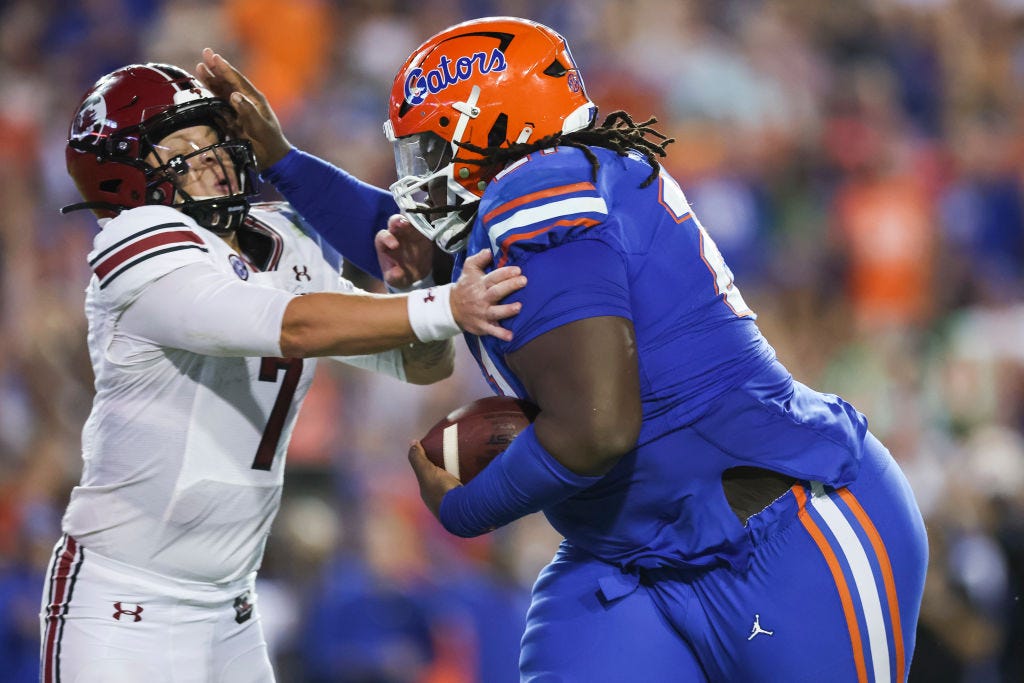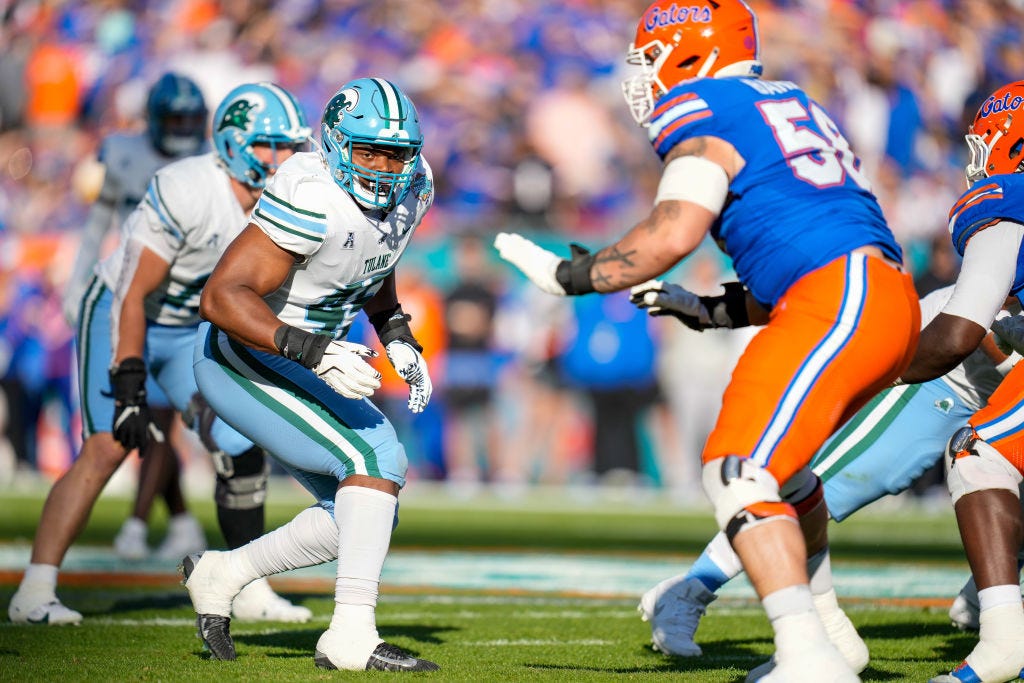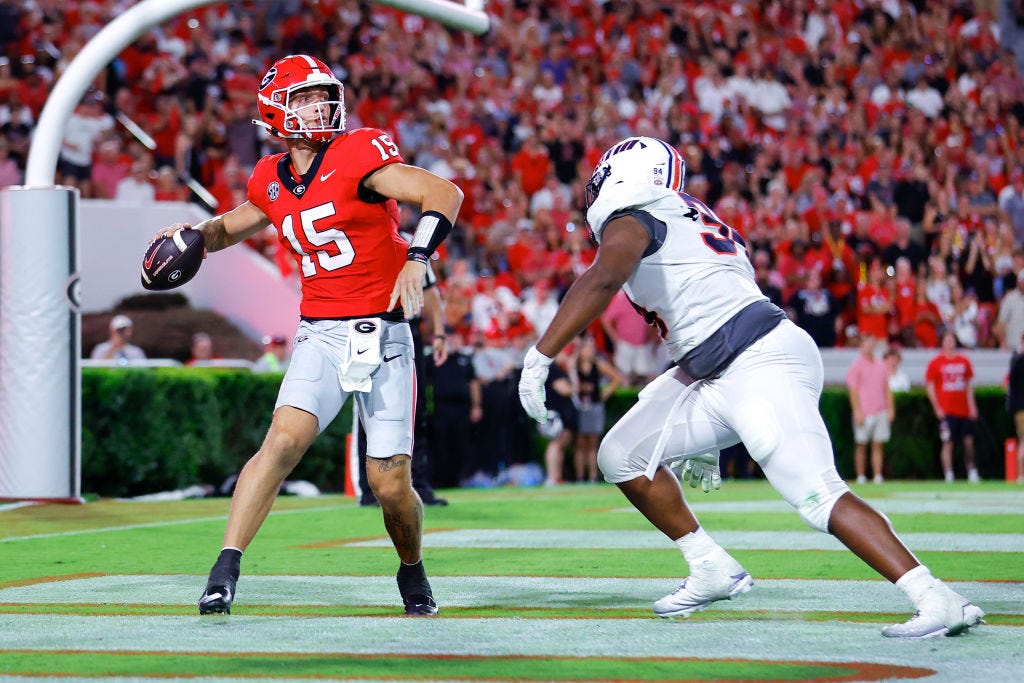Defensive Pro Day Standouts: Which Non-Combine Studs Made Waves at Workouts?
Over 2700 players participated in the pro day process. On defense, we can use athletic modeling to find out who put up the best workouts. Will any succeed?

This is the defensive version of the last post I wrote, which focused on the offense. You can find it here. The intro is the same because it feels pointless to rewrite it, so if you’ve read the offensive intro, skip right to the first position, defensive tackle.
Every year, there are “snubs” who do not find themselves invited to the NFL Combine but nevertheless make an impact in the NFL, sometimes even as rookies. Twenty-five or so players in a given year will be drafted without having that combine invite and a good deal more will end up as high-impact undrafted free agents.
Part of the process that identifies them to NFL talent as worthy of selection is the pro day. Most players who fail to earn a combine invite aren’t good prospects and part of the reason they aren’t good prospects is because they lack the elite athletic prowess characteristic of a successful NFL player.
But sometimes players are much more athletic than their invitee counterparts and deserve a second look.
In the past, these players have included Tyreek Hill, Phillip Lindsay, Kobie Turner, Tyler Huntley, Mohamoud Diabate and Poona Ford.
Further back, we can identify players like Adam Thielen, Doug Baldwin, Victor Cruz, Malcom Butler, Julian Edelman, Chris Harris, James Harrison, Fred Jackson, Sam Shields, Osi Umenyiora, Sebastian Vollmer, Wes Welker and Antonio Gates.
While this exercise is good at identifying the types of athletes that could be NFL players, it’s important to note that while some of them weren’t good enough athletes to be considered for the next level, many of them weren’t invited to the NFL Combine because they weren’t perceived as very good players.
That means many of the resumes will be underwhelming – but it’s always possible to be better at the next level than one was in college.
The models used to identify standout players eschews Relative Athletic Score in favor of position-specific models that recognize that the 40-yard dash matters more at cornerback than defensive tackle. We’ll also be looking at players who were explicitly not invited to the NFL Combine, even if they didn’t work out there. A good example of such a player would be Louisville’s Ashton Gillotte, who would have been one of the top-performing edge rushers on this list.
Of the over 2,700 players who participated in pro days this year, which ones stood out on defense?
Defensive Tackle
There are two archetypes the model has focused on at defensive tackle: three-technique and nose tackle. While there are 309-pound nose tackles and 315-pound three-techniques, the majority of instances seem to separate nose tackles from undertackles at the 310-pound mark. The model produces two scores, so any player that might be a candidate for one position but meets the weight filter for another can be evaluated.
For example, Jay Ratliff, who weighed in at 292 pounds at his pro day, played nose tackle for the Dallas Cowboys for seven years before playing three-technique for the Chicago Bears for three years. Ratliff had an above-average nose tackle score (and a high-level three-technique score). It maybe wasn’t the best use of him, but it was a valid use, at least according to these metrics.
B.J. Hill, on the other hand, has played ten times as many snaps at the three-technique position as he has the nose tackle position, which matches his college usage at NC State. His three-technique athleticism score is better than his nose tackle score despite weighing 311 pounds. So too with Terrance “Pot Roast” Knighton, who weighed 321 pounds but was devastating lining up over the B gap or even over the tackle, which he did in Denver at defensive end.
No model is perfect.
For undertackles, the model uses three-cone time (both raw and adjusted for weight), weight (the more, the better), and 20-yard split data. Players also need to pass a threshold at broad jump – 9’3” or greater.
For nose tackles, weight and arm length help. So too does the bench press – unusual given how little the bench generally matters. The model favors a series of filters – better than average weight-adjusted ten-yard split and short shuttle times as well as a relatively easy threshold to pass in the three cone (7.95 seconds or faster).
But what seems to help the most is weight-adjusted explosion numbers, with numbers in the vertical leap and broad jump providing the most support for a nose tackle’s athletic profile.
Desmond Watson, DT Florida
I don’t think that Desmond Watson is a real “pro day” standout – I included him here (and, later in this piece, a different player posing the same problem at cornerback) because he demonstrates the limitations of this particular approach to modeling. He weighed in at his pro day at 464 pounds. The fact that he was able to move at football speeds – slow football speeds, but football speeds – is impressive by itself.
Because nose tackle workout metrics rely on size adjustments, perhaps because it is the position that relies more on force than on pure speed, a bigger defensive tackle is going to score better. In fact, weight is one of the inputs.
Whoops.
Not only that, the model relies on “expected” outcomes in some workouts, including the short shuttle. Those expectations are built on… weight. So, Watson was “expected” to run a 5.62-second short shuttle. He ran a 5.28-second short shuttle, making him one of the best all-time size-adjusted short shuttle performers at the position.
His plus-0.34 second time places him fifth since 2010, just behind Henry Anderson and Tyson Alualu and just ahead of J.J. Watt and a Nebraska tackle named Ben Stille, a 2022 UDFA who is still in the league. It’s a good test, but not very applicable here. He is also the only player in the top 250 of the metric to run slower than five seconds (congrats to 253rd-ranked Michael Jasper and 581st-ranked Josh Tupou).
Using this model, an equivalent short shuttle at 320 pounds would be 4.39 seconds.
Many of these models were developed by an unsophisticated modeler (me) and used linear relationships when that’s not really how these things play out. If they were, Watson would merely have to drop to a svelte 260 pounds to run a sub-4.0 second short shuttle. This linear approach is simple, understandable and useful for about 99.9 percent of cases. But, on occasion, you get a Desmond Watson.
I do think his short shuttle time is impressive at his size, as is his vertical leap of 25 inches – better than some athletes at 200 pounds. But impressive isn’t the same as functional and he may not be quite the nose tackle the model says he’d be.
Is he worth a shot on an NFL roster? Absolutely. I’m just not sure the model is useful here.
OK, Watson isn’t a real standout. Who stood out in a way better suited for the modeling approach here?
Nick Gaes, EDGE South Dakota
A 275-pound edge defender for the South Dakota Coyotes, Nick Gaes has excellent workout numbers for both edge rusher and defensive tackle. Unlike the next player on this list, his workout numbers are better for a DT than for an edge and he’s listed in Dane Brugler’s draft guide at the Athletic as a defensive tackle. So, we evaluate as one here.
Gaes primarily played on the edge this last year, but played DT in his prior three years at South Dakota. Those years were more productive for him so that might be his NFL future.
The South Dakota native ran a stunning 6.97-second three-cone, a big reason he has one of the best scores in the dataset this year regardless of combine invite. The 2.82-second 20-yard split is outstanding and the 9’8” broad jump easily clears the thresholds for the position.
A one-time all-conference player for the extremely talented Missouri Valley Conference, Gaes hasn’t made any all-FCS teams like teammate and fellow edge rusher Mi’Quise Grace, a redshirt sophomore. His production is good, not great, which may be necessary to grab the attention of NFL scouts when playing at the FCS level.
Adin Huntington, EDGE Tulane
Because weight is an input here and at edge rusher, Tulane defensive tackle Adin Huntington actually looks like a better edge rusher through these models than a defensive tackle. Brugler lists him at edge rusher but at 281 pounds, he could strongly be considered for a role on the inside by many teams.
Either way, he looks like a high-level athlete.
He ran his 20-yard split 0.2 seconds faster than defensive tackles of his size are expected to, a good start. He also easily cleared the broad jump threshold with his 10’6” jump. His outstanding 38-inch vertical leap doesn’t figure into the model but is worth noting for those looking to verify his explosive potential. Add in an above-average three-cone for his size (7.52 seconds) and you have the makings of a good athlete at the position.
He had a good season at edge rusher for Tulane, but played on the inside at Louisiana-Monroe, where he played in 2023 – just like Gaes. His numbers on the inside were better, but it may be splitting hairs – he was all conference in each of the last two years.
He led all defensive tackles in the FBS in pressures in 2023 with 48, also leading the league in sacks at defensive tackle, according to PFF, who do not distinguish half-sacks from full sacks.
A super-athlete with elite production at the G5 level, he’s not currently projected to be drafted. But I suspect that will change.
Christian Dowell, DT Tennessee-Martin
Christian Dowell is a pure nose tackle. Last year, he played 484 snaps. 442 of them were in the A gap. He had an outstanding year at the position, but nose tackles aren’t valued very highly by NFL GMs unless they have pass rush upside like Jordan Davis or Dexter Lawrence. The upside is there for Dowell, at least athletically, but the production is not.
His pressure rate of 6.3 percent is unimpressive even when only looking at players who primarily played in the A gap. By contrast, likely draft pick CJ West had a pressure rate of 10.5 percent.
As an athlete, Dowell had a good score as both a three-technique and nose tackle though Tennessee-Martin was correct not to move him around too much. His score as a nose tackle is fantastic – he has just long enough arms (33 1/4 inches) to get bonus points in the model, a solid ten-split at 1.76 seconds and a qualifying three-cone at 7.88 seconds.
Of course what really matters at NT is his 9’1” broad jump, seven inches beyond his size expectation. Of the 178 defensive tackles over 320 pounds I have in my database, only 10 have jumped further in the broad jump. Despite that cohort containing players that range from first-round picks to undrafted free agents, combine invitees and pro day standouts who never got a second look, the hit rate for that group is pretty high.
It includes Haloti Ngata, Jordan Davis, Michael Pierce, Marcus Stroud and Bobby Brown. One of those players is in this draft class (Zeek Biggers), so really this is out of nine, not ten. Throw in Eli Ankou and Travis Jones and you have a pretty solid group of peers. And also a surprising number of Baltimore Ravens.
Other notables: C.J. Warren, St. Thomas (MN); Sebastian Valdez, Washington; Dezmond Tell, Louisville
Edge Rusher
The position that colleges throw their best big athletes at also happens to be the position where athleticism may matter the most. No model – or scout – will have a hit rate of 100 percent. But the top ten athletes in the model since 2005 include Von Miller, J.J. Watt, Mario Williams, DeMarcus Ware and Shawne Merriman. The “less impressive” top ten athletes are still contributors – Connor Barwin, Rashan Gary, Frank Clark and Odafe Oweh.
Keep reading with a 7-day free trial
Subscribe to Wide Left to keep reading this post and get 7 days of free access to the full post archives.








